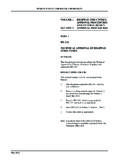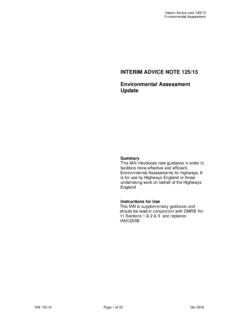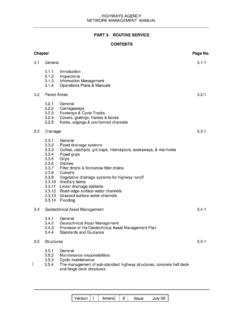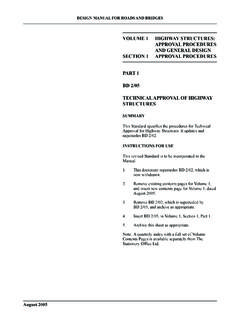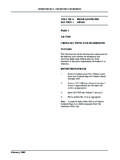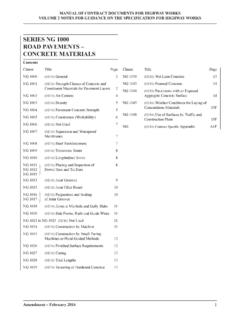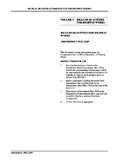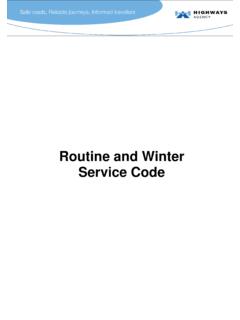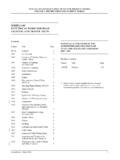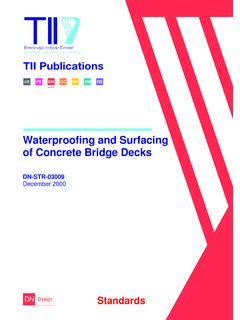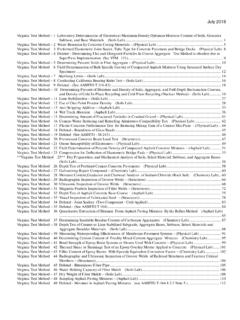Transcription of INTERIM ADVICE NOTE 96 /07 Revision 1 GUIDANCE ON ...
1 INTERIM ADVICE Note 96/07 Rev 1. GUIDANCE on implementing results of research on bridge deck waterproofing INTERIM ADVICE NOTE 96 /07. Revision 1. GUIDANCE ON IMPLEMENTING. RESULTS OF research ON. bridge deck . waterproofing . Summary This INTERIM ADVICE note provides GUIDANCE on improving the performance of surfacing to bridge decks, particularly for surfacing less than 120mm thick, and provides ADVICE on the application of bridge deck waterproofing systems to concrete aged less than 28 days. This ADVICE is based on the results of recent research carried out on currently BBA certified bridge deck waterproofing systems.
2 Instructions for Use This IAN takes immediate effect. Change bars indicate revisions IAN 96/07 Page 1 of 12 Aug 07. Rev 1. INTERIM ADVICE Note 96/07 Rev 1. GUIDANCE on implementing results of research on bridge deck waterproofing Table of Contents 1. Introduction 3. 2. Improving Surfacing Performance 4. Introduction 4. Surface and sub-surface drainage 4. Surface preparation and application of the waterproofing system 5. Surfacing and waterproofing system 5. Bond of surfacing to the waterproofing system 7. Deformation resistance 7. 3. Lapping onto existing waterproofing systems 9. 4. waterproofing Systems Applied to Young' Concrete 10.
3 Introduction 10. Factors affecting performance 10. GUIDANCE on the application of waterproofing to young' concrete 11. 5. Implementation 12. 6. References 12. IAN 96/07 Page 2 of 12 Aug 07. Rev 1. INTERIM ADVICE Note 96/07 Rev 1. GUIDANCE on implementing results of research on bridge deck waterproofing 1. Introduction Highways Agency (HA) requirements relating to bridge deck waterproofing and surfacing and are contained in Departmental Standard BD 47/99 waterproofing and Surfacing of Concrete bridge Decks (Design manual for Roads and Bridges, Volume 2, Section 3, Part 4). These requirements concern the total thickness of the surfacing (a minimum of 120mm), the material that directly overlays the waterproofing system (sand asphalt), the bond of the surfacing to the waterproofing system and the sub-surface drainage.
4 While the performance of surfacing is generally satisfactory if the total thickness is at least 120mm (as specified in BD47/99), premature failures have occurred when the thickness has been reduced. Although this reduction is outside current standards there may be good practical and/or economic reasons for considering reducing the thickness of the surfacing. Part 1 of this IAN reviews research carried out to understand the performance of surfacing to bridge decks, particularly where it is less than 120mm thick and provides GUIDANCE on reducing the risk of failure by emphasising the importance of sub-surface drainage, strengthening the bond requirements, specifying deformation requirements and specifying maximum air voids on all asphalt mixtures.
5 BD 47/99 also specifies the requirements relating to the application of bridge deck waterproofing which leads to waterproofing systems being normally applied a minimum of 28. days after decks are cast. Recent research has shown that the performance of waterproofing systems should not be adversely affected by application to concrete aged 7. days or more. Therefore, Part 2 of this IAN provides ADVICE on the application of bridge deck waterproofing systems to concrete aged less than 28 days. The risks associated with these proposals can be mitigated by careful planning and observing the ADVICE /procedures within this ADVICE note.
6 However as these risks will be taken by the Highways Agency contractors must seek formal approval from the HA Project Manager for that particular scheme. Project Managers should confirm that proposals comply with the requirements of this IAN. and that the identified justification (cost/time savings) are appropriate. Project Managers should be aware that significant benefits can be realised by the reduction in programme offered by this IAN and these should be reflected in the magnitude of the identified benefits. The decision to implement these procedures is at the discretion of individual HA Project Managers.
7 IAN 96/07 Page 3 of 12 Aug 07. Rev 1. INTERIM ADVICE Note 96/07 Rev 1. GUIDANCE on implementing results of research on bridge deck waterproofing 2. Improving Surfacing Performance Introduction BD 47/99 requires waterproofing systems on concrete bridge decks to be overlaid with a 20mm thick sand asphalt protection layer and binder and surface courses so that the total thickness of the three layers is 120mm. This minimum thickness should always be aimed for, however, the total thickness on some bridges has to be reduced for practical and/or economic reasons and, in such cases, a number of premature failures have occurred when the asphalt has broken up and potholes have developed.
8 The failures have been attributed to several factors, including: The accumulation of sub-surface water in the asphalt Poor bond of the asphalt layers to the waterproofing system Excessive thickness of the waterproofing membrane Low compressive modulus of the waterproofing system Low fatigue resistance of the asphalt layers research has been carried out to investigate these failures and develop GUIDANCE to improve the performance of bridge deck surfacing. This research has highlighted several changes that are necessary to existing HA GUIDANCE , including: Emphasis on the importance of sub-surface drainage Strengthening bond requirements Specifying deformation limits for all mixtures within 100mm of the surface Specifying maximum air void contents for all asphalt mixtures.
9 The revised GUIDANCE is summarised below and is intended to develop further the existing HA ADVICE for bridge deck surfacing. Surface and sub-surface drainage Surface drainage systems, longitudinal gradients and cross falls should be provided to minimise the amount of water that can enter and accumulate in the surfacing on bridges. Edge drains should be provided to drain the full depth of relatively permeable surface courses ( air void content > 6%) (i) at the low points of the deck and (ii) where the flow of sub-surface water though the surface course is impeded, at expansion joints that are not the buried type.
10 Sub-surface drainage should be provided at the level of the waterproofing system as specified in BD 47/99 at all locations were water may accumulate. The vertical faces of the joints between adjacent laid widths (rips) of asphalt are normally sealed with bitumen to prevent water ingress. However, a fully sealed joint will prevent the horizontal flow of water through the asphalt layers. Provision must be made to ensure good bond between the adjacent laid widths, but in a way that does not allow water to accumulate in parts of the asphalt layers. The upper surface of a surface course joint should never be coated with bitumen after it has been compacted IAN 96/07 Page 4 of 12 Aug 07.
